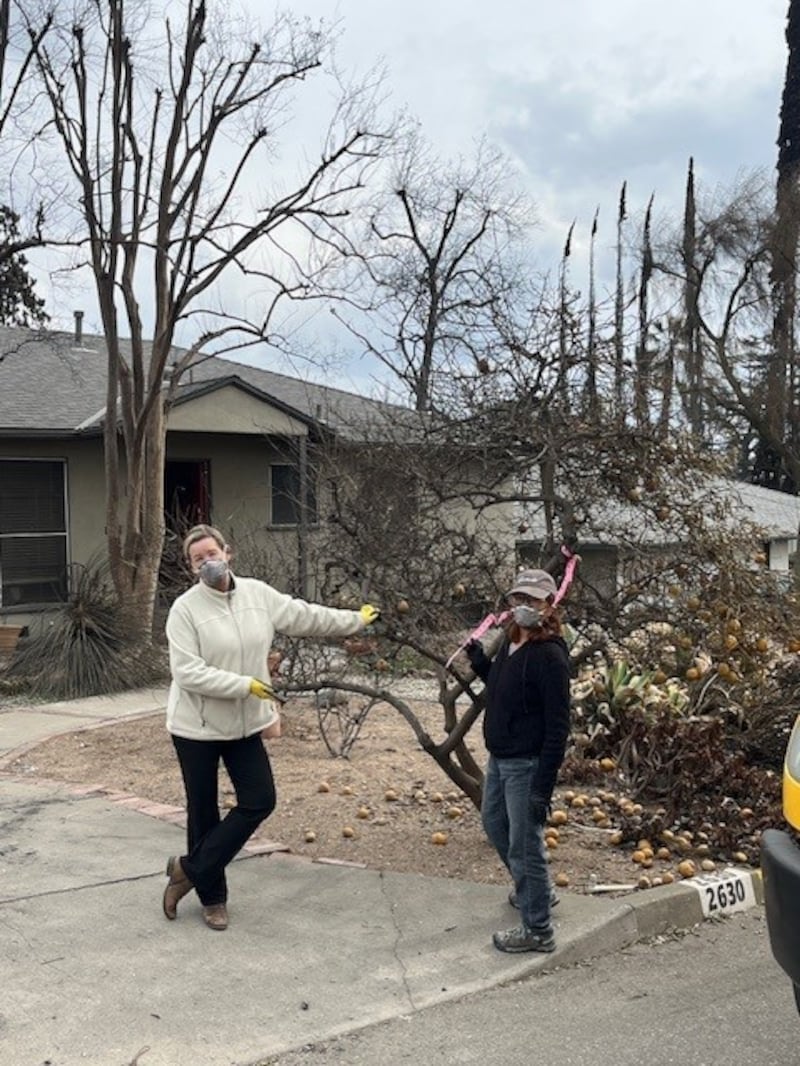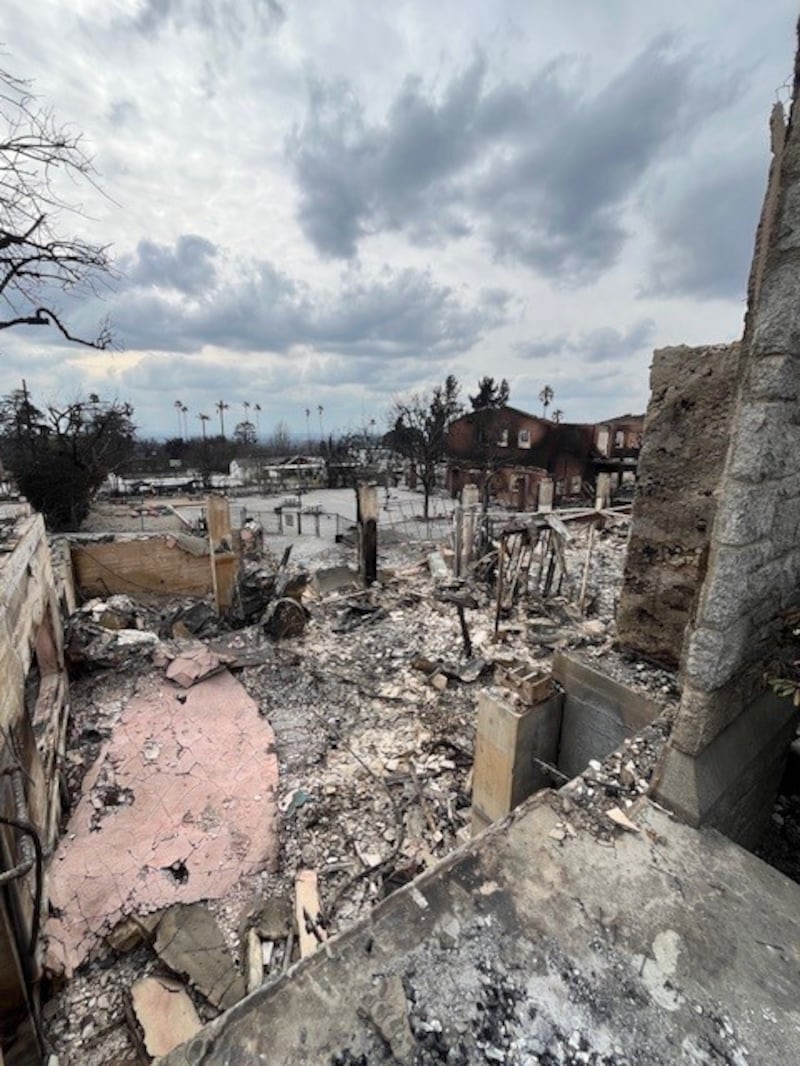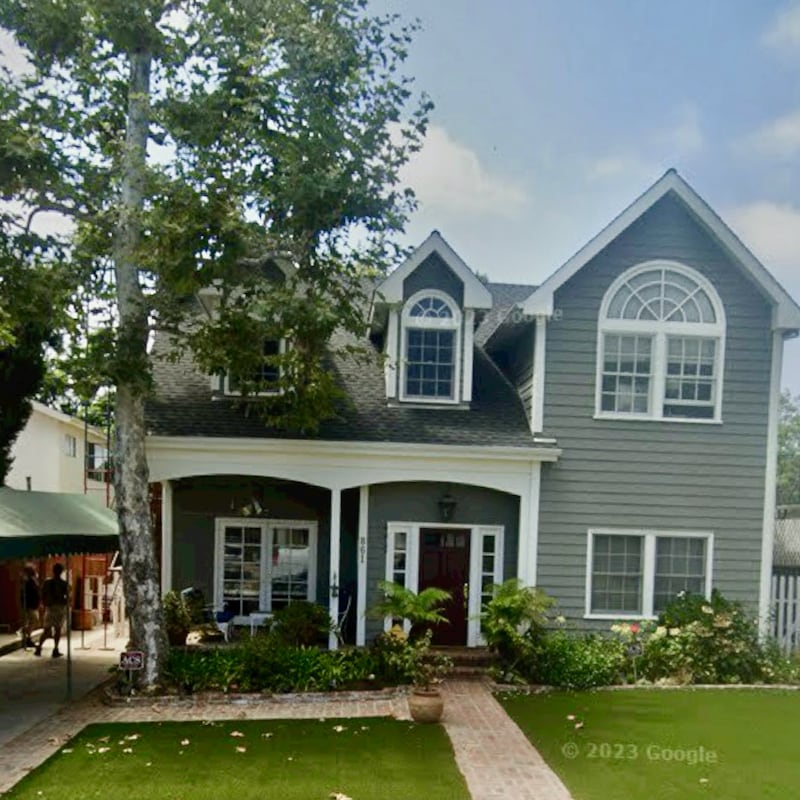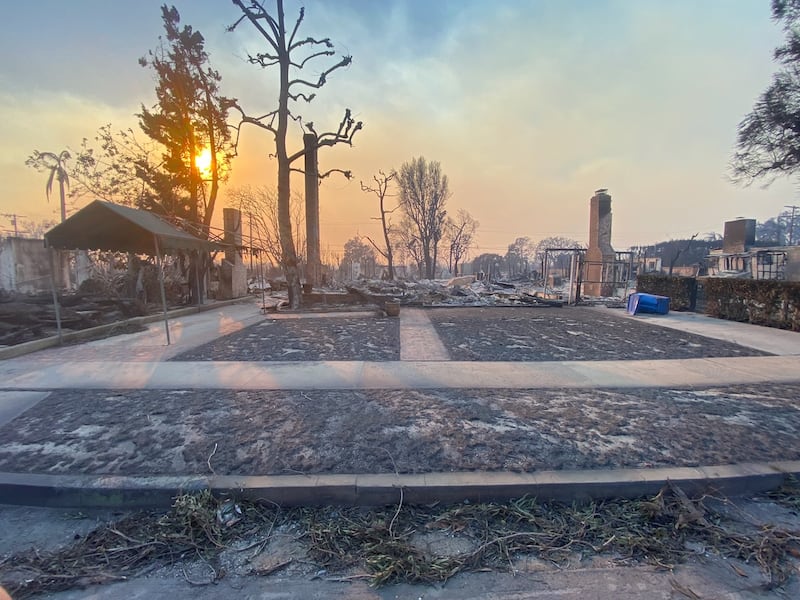The lemon tree at the front of Diane Park’s house is scorched and blackened. Charred fruit lies scattered across the lawn.
On Homepark Avenue, the cul-de-sac where she has lived for 20 years, the neighbours, she laughs, “knew me by my fruit”.
“I had a wonderful orange tree. That huge tree over there is an incredible avocado tree. I had an incredible crop this year.”
She shrugs. Her house is one of two homes spared on the small avenue in Altadena that was ravaged by the Eaton Fire. Neighbouring homes, just a few metres away, many built in the 1950s, have been razed.
READ MORE
As we stand on an overcast Saturday morning, those homes are now black ash, twisted metal and ravaged chimney blocks. Two big churches at the end of the avenue have also been gutted and hollowed.
A big yellow Hollywood moving van is parked outside Park’s place. Her friend Carolyn Albin flew in to help her pack her belongings because of the fear of looters. She is about to lock up. It will be at least six months before she can return. Right now, she is staying with a friend and has no clear plan of what the future looks like.
Both women are wearing masks because the air is still choky, malevolent. The only other humans to be seen are professionals sifting through incinerated homes wearing hazmat suits. Driving through Altadena now is an eerie, disorienting experience; avenue after avenue of utter devastation.

President Donald Trump hinted at it when he visited on Friday, without saying it; the effect is like driving through a post-nuclear suburbia. And yet, every so often you pass a street somehow spared from the vagaries of the inferno, the houses immaculate and shrubbery gorgeous and you are transported to what was clearly a fully-realised version of the American suburban idyll.
“Altadena was an old, funky, working-class, middle-class neighbourhood,” Park says.
“Coming up here was fun. People were just down home . . . you could hang. For example, my ex is a big, tall, Polish white guy. I’m Hawaiian-Korean. So, we would hang out down in Pasadena and people would get whiplash looking at us. But up here, it was cool. The vibes were beautiful. Altadena was an incredible neighbourhood.

“People came west and started to establish Pasadena - the blueblood white people and they didn’t want that . . . mix, so they started pushing everybody up hill. So, you have a very established black community on the west side, Japanese, Hispanic - everyone who wasn’t white. And it became a really cool place. A lot of artists, creative people moved in. A lot of mixed marriages. Everybody wants to come back and rebuild. But is that really going to happen? Because these people . . . what do they have to . . .”
Her voice trails off. Most of the Los Angeles fires are out now. On Saturday night, luscious raindrops began to hit the dusty windowpanes and Sunday brought a deluge to the city, along with the threat of mudslides along the steep canyon roads that lead down from the mountains. The fabled views from the Hollywood Hills were obscured by a winter haze - and it was chilly.
Sunday also marked the fifth anniversary of Kobe Bryant’s death, the city’s enduring LA Lakers cult figure. So, it was a gloomy, quiet weekend. A thousand questions about the fires remain suspended over the metropolis, focused on everything from the city management to where Los Angeles goes from here. Arson and electrical faults are being examined as primary causes.
The scale of destruction is unfathomable, too vast for human imagination. Eighteen people lost their lives in the fires which sped down from the hills over the incorporated community of Altadena and, about 40 miles across the city, by the coast, to Pacific Palisades with its stunning views of the ocean.
Some 18,000 homes, schools, churches and businesses were either destroyed or badly damaged, at an estimated cost of $250 billion. The Los Angeles Times reported on Sunday that the now-tamed or extinguished fires leave “a burn zone two-and-a-half times the size of Manhattan”.
Sue Kohl, who lost her home and her business in the Palisades Fire, remembers something a firefighter said to her in the days after she surveyed the ruins of the street where she had raised five children. He told her that the houses, once caught in the path of the hailstorm of embers, were exploding into flames “at a rate of about one per minute”.
When we speak on the phone, it is late Monday evening and getting dark in the razed-out heart of the Palisades, still under the watch of the National Guard. Kohl is staying with a friend but has a cartographer’s sense of the Palisades maze of avenues and curling, hilly streets as she guides me through the empty, charred thoroughfares as dusk falls.
“So, if you go another block down Sunset, then a right on Swarthmore, you come to the Alphabets and that’s where we live.”
She describes the Palisades as it was just a few short weeks ago. Kohl is Los Angeles-born and agrees that most people felt blessed to live there.
“You have the mountains behind you. Each morning I’d take a two-hour walk with the dog - down to the ocean. Back up the bike trail. Just . . . a charming place. Culturally it is about as close to small-town Midwest as you can get and people would think that odd about a place where a bunch of movie stars live. But it is the truth. You can’t walk around that town or go to the market without running into people you know. It is a friendly, friendly place which is why I believe that vast majority of people will build back and return.”
In the television reports, the shorthand portrayal of the Palisades is that it was a hilly citadel populated by the mega wealthy and Hollywood royalty. When president Trump paid his morning visit to Los Angeles, it was noted with dismay by Altadena’s displaced that he visited Palisades but not their community.
Kohl has built up a successful realtor’s practice so is well-versed in the transformation in profile and wealth of Los Angeles’s neighbourhoods over the decades. She herself grew up in a part of Beverly Hills in the 1960s and 70s that was “the very bottom of the rung”. But now, she marvels, houses there fetch anything from eight to $20 million.


In the 1970s and 80s, people on steady, average incomes could afford to build and settle in Pacific Palisades which, to her teenage mind, “seemed very far out”. Many of those families still live there. But the intense beauty – the coastal views but also the dazzling variety of horticultural life bursting through - has pushed houses prices into the multiples of millions.
The population of greater Los Angeles was 7.5 million in 1980. It is just over 18 million today. The population within the city limits is 3.8 million, up from 2.9 million in 1980. The 2024 Homeless Count Initiative census reported that over 75,000 people were unhoused in Los Angeles county, with 45,000 of those living on streets within the city perimeters. The fires have displaced around 150,000 more people - some for years to come. Homeowners whose houses went in the fires had already lost insurance.
Future insurance is, right now, an unnavigable minefield. The fear that speculators will come and buy those who lost their homes out of their land and displace long-time ‘ordinary’ Altadena and Palisades residents are chief among the myriad worries.
“We need a new relationship with fire,” says George Whitesides, the Democratic congressman for California’s 27th district, when we speak on Wednesday afternoon.
“We need to build communities that are resilient to what is unfortunately a natural part of the southern California landscape. That is going to entail a lot of things - from how we build, how we relate to our wildlands, to our power infrastructure. And it is obviously going to involve a lot of big conversations about the future of insurance. And these are challenging conversations to have, because they involve millions of people and trillions of dollars. But the most important thing right now is to take care of the afflicted.”
Even as the fires burned, the social response - food and clothing banks, donations - was phenomenal. The Federal Emergency Management Agency has set up centres in both communities. The desire to rebuild the destroyed communities is strong. But they know they cannot fully replace what has been lost.
“You know, I think it has to look slightly different,” Kohl says of a reimagined Palisades.
“And it needs to be built in a slightly different way. Houses that are fire resistant. No eaves. Triple-pane windows. When people rebuild they are going to remember very well the reasons why they are rebuilding. And some of those very old houses - a neighbour up the street was about to celebrate the 100th year of that house. Then, it was burnt.”
If you have never driven through Los Angeles- as I had not done until this week - then nothing can prepare you for the sensory and visual overload. The scale of the city is at once wonderful and absurd, running some 44 miles north to south and 30 miles east to west. What makes it navigable, in the mind, is that it is divided into countless distinct neighbourhoods.
Sunset Boulevard, one of the most storied streets, runs across the north of the city, just below the hills for 23 miles, intersected by the drives and canyon roads running uphill from the city heartland to the hills. It gets steep quickly and the narrow residential streets feel haphazard - homes built on stilts; box houses; wooden houses, all eras and influences of architecture on display and all draped in the city’s riotous, gorgeous plant life.
When you throw in the Hollywood dream machine and touristic allure of Tinseltown and a mesh of ethnic cultures and that pastel skyline, you find yourself in a city fantasia, as though concocted by hot-rod racers, architect horticulturalists and movie dreamers. Los Angeles is relentlessly forward-driven but few cities can be as in thrall to their origin story as here.
The golden era of Hollywood may have passed but still the tourist buses roam looking for proof of the substance behind the make believe - up here on Mulholland Drive is Jack Nicholson’s gate; there is the Hotel Roosevelt where Marilyn Monroe lived, there is Whisky a Go Go, largely unchanged from when The Doors played night after night. The oddest thing is how hauntingly quiet the winding sloping streets just above Sunset Boulevard have become.

Fires are nothing new in Los Angeles. Since the recent infernos, there has been a spike in viewing figures on YouTube of the 1962 documentary, narrated by William Holden, titled Design for Disaster: The Story of The Los Angeles Conflagration. It opens with a reference to the Santa Ana winds, which feature in the songs of everyone from the Beach Boys to Lana Del Rey to the LA punk band Bad Religion, who in 2004 warned:
“When the hills of Los Angeles are burning/Palm trees are candles in the murder wind/So many lives are on the breeze/Even the stars are ill at ease/And Los Angeles is burning.”
“On nights like that,” Raymond Chandler once wrote about the Santa Ana, “every booze party ends in a fight. Meek little wives feel the edge of the carving knife and study their husbands' necks. Anything can happen.”
On January 8th, whatever about its supernatural qualities, the Santa Ana was at its most powerful. In Altadena, Diane Park left on the Monday evening, even before the official alert went out. She could see the flames coming down from the Eaton canyon. And she’d evacuated before.
“I grabbed a few things. You think you’ll be coming back the following morning.”
The same happened across in Pacific Palisades in Sue Kohl’s neighbourhood. Nobody believed the fires would come so far down; they were located on ‘the flats’ of the Palisades. But the winds were blowing at 100 miles per hour and chasing the flames towards the residences. A different wind pattern would have meant incineration for other communities close to the scrublands.
In the days afterwards, there was anger at city officials, with mayor Karen Bass coming under heavy criticism; grievances that the firefighters didn’t have the resources to fight the inferno as they might have done.
“I don’t want to blame anyone,” says Kohl. “Because nobody has seen wind like that. That said, the fire budget was cut. The reservoir at the top of the city was empty for a year because it was being repaired and they wanted to put a cover on it. So yeah there are people in charge who could have done a better job. You can’t blame them for the fire.
“A fireman told me that in the Alphabet, it was burning at a rate of a house per minute. There was nothing they could do. They hooked up to a hydrant and the water came out three feet. Every bad thing that could happen did happen. Most people, I can say, are very disappointed by how it was handled by our top officials. They are all good people and everyone makes mistakes. But, oh my God.”
When the flames died, the television news anchors left the city. In addition to the slow, bureaucratic nightmare and expense of rebuilding or finding new homes for those directly affected come secondary nightmares.

Future fires will visit Los Angeles. The immediate-term toxicity of the city air is an issue. The controversial history of Los Angeles’s water supply mirrors the city in cinematic drama and intrigue and spawned one of its most celebrated films, Chinatown. Now the sudden loss of so many entire communities has sharpened the focus on a future problem.
“I think housing is a fundamental issue” says Liz Koslov, assistant professor in the department of urban planning at UCLA, when asked about the trajectory of the city over the decades ahead.
“I came into housing because I wanted to understand people’s every day experiences and what shapes their lives. It is largely to do with the commodification of housing. Because in some cases there is true scarcity but in other cases it is manufactured. There are a lot of empty homes, investor-owned homes, short-term vacation rentals, Airbnbs, which remove viable housing from the market.”
She talks about the ways in which spiralling property prices manipulate and dominate life patterns. A small, but telling example: at UCLA, faculty and graduate students no longer live close to campus.
“That harms the intellectual life of the campus because you can’t just go to the pub and get a drink after work if you have a two-hour commute.”
Everyday life issues- childcare costs, ageing parents, the impossibility of homeowning for many - are confronting Los Angelenos of Koslov’s generation.
“There was a study not so long ago about the inverse relationship between the family size and the housing space where people like my age, where it’s like, me, my partner and our four-year-old in an extremely small Hollywood apartment, and then people whose homes we drive past in Beverly Hills, and it is enormous and there is one person living in there. So, there are opportunities to rethink how communities are organised - downsizing or communal spacing and be less isolated as they age.”
The separate question - as to whether it is not a magnificent human folly to establish communities and homes, however beautiful, in wildlands prone to sudden volatile infernos - will always be there too.
“It really is a moment where we need to have a national conversation about specifically wildfire-resilient cities but more generally how we deal with climate risk as a country,” says George Whitesides.
“It is obviously going to involve a lot of discussion about the future of insurance. Obviously our number-one priority now is taking care of those afflicted. But very soon we need to engage in that broader conversation. And it’s a hard one because when you have a wet year or no wildfires and you are spending several billion dollars on wildfire preparedness, people will ask: what are we doing? But then you have this - which could be the most expensive natural disaster in American history.”
- Sign up for push alerts and have the best news, analysis and comment delivered directly to your phone
- Join The Irish Times on WhatsApp and stay up to date
- Listen to our Inside Politics podcast for the best political chat and analysis





















